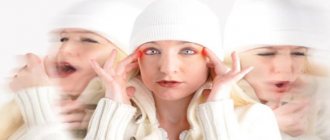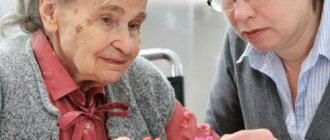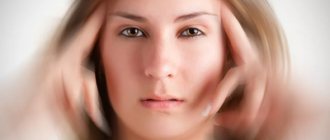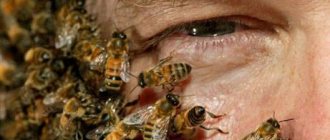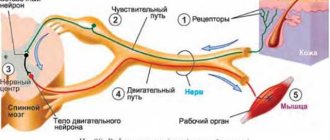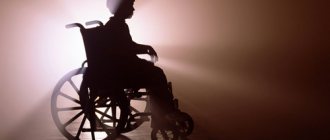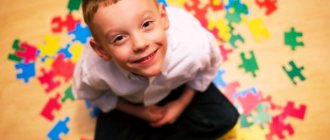Infantile cerebral palsy is a group of non-progressive diseases of a chronic nature, which are manifested by various impairments of motor functions as a result of brain damage. But this is not a hereditary pathology, but an acquired one.
However, the effect of etiological factors can manifest itself during intrauterine development (due to intrauterine infection, obstetric pathology of the mother, fetal hypoxia and other teratogenic factors).
Brain damage can occur during childbirth or in the first weeks after birth (as a result of central nervous system infections or Rhesus conflict).
Cerebral palsy does not progress, that is, brain damage does not worsen over time, and motor defects can be partially corrected. However, in the absence of appropriate methodological exercises and care, children may experience severe complications.
Causes and risk factors
A defect in the development of a region of the brain can occur both before birth and in the early stages of life.
Statistics show that cerebral palsy most often affects premature babies (about half of the cases), since they are most vulnerable to influencing factors.
The main reasons for the development of the disease in children before and during childbirth:
- fetal hypoxia;
- large baby size;
- incorrect position in the womb;
- maternal infections;
- mother's narrow pelvis;
- premature placental abruption;
- Rh conflict between pregnant and newborn;
- rapid pace of labor;
- drug induction of labor or puncture of the bladder.
Factors that can cause cerebral palsy after childbirth include:
- serious infections (meningitis, encephalitis and others);
- lead poisoning;
- traumatic head injuries;
- situations that can cause oxygen starvation (foreign objects in the respiratory system).
All of these factors are not a 100% guarantee of the development of the disease, but are significant reasons that can provoke cerebral palsy.
Features of motor correction in cerebral palsy
Most often, orthopedic disorders in cerebral palsy occur as a result of disturbances in the patient’s motor activity. Negative changes in the skeletal muscles lead to the formation of contractures (tissue scarring) and disorders in the joint and bones. This causes pain, limits the patient’s movements, and he develops forced (antalgic) postures.
Treatment of the consequences of cerebral palsy is always complex. The treatment program depends on the severity and characteristics of the disease. Orthopedic correction of the consequences of cerebral palsy consists of surgical correction of deformities of the arms, legs, and joints.
The purpose of surgery is to improve the child’s motor activity. There are many types of surgical interventions aimed at motor correction of the consequences of cerebral palsy in children: plastic surgery of muscles and tendons, surgery on bones and joints, plastic surgery of ligaments, tendons, bones, etc.
The choice of techniques depends on the problems being solved and the age of the patient. Make an appointment with a pediatric orthopedic doctor to learn more about the possibilities of correcting the consequences of cerebral palsy in a child. Our specialists will assess the patient’s condition and draw up a comprehensive treatment program for cerebral palsy.
Other diseases:
- Congenital and acquired foot deformities in children
- Shortening of the lower limb
Signs of cerebral palsy in a child
Doctors are not able to notice and identify the first signs in every case, so an invaluable diagnostic role is given to the mother, who spends the most time with the baby.
First signs
How does cerebral palsy manifest in an infant (first manifestations):
- there is a clear asymmetry between the buttocks and the torso as a whole;
- the curvature of the spine in the lumbar region is poorly manifested;
- no fold between the buttocks;
- muscle tone in the limbs (tight or flaccid);
- muscle cramps, paralysis;
- poor sleep, anxiety, loss of appetite;
- weakening of the muscles on one side of the body and increased tone in the other half, as a result, shortening of the limbs, curvature of the spinal column;
- movements with only one arm or leg;
- The child cannot turn his head independently.
2 months and older
Symptoms of cerebral palsy in infants from 2 months:
- trembling of the limbs when trying to lift;
- stiffness in the arms and legs when moving;
- it is difficult for the baby to control his head when trying to lift it;
- problems during feeding (weakness of the sucking reflex, difficulty biting, tongue sticking).
6 months and older
Signs of illness from six months:
- it is difficult to roll over on your side on your own;
- the baby does not control the process of raising his head;
- feeding problems continue;
- the child extends one hand, and the other clenches into a fist.
10 months and older
Symptoms from 10 months of age:
- the baby cannot sit down on his own and remain in this position without outside help;
- doesn't try to talk;
- does not respond to his name;
- When moving, he uses one arm and leg, and drags the opposite ones behind him.
12 months and older
Signs of illness from year to year:
- does not crawl independently;
- cannot stand without assistance;
- does not speak simple words;
- does not look for toys that hide in his presence.
The following video is about the symptoms of cerebral palsy, filmed by the TVC program “Doctors”.
CLASSIFICATION
Currently, at the Vremena Goda clinic, we adhere to the classification and terminology according to ICD-10:
Class VI DISEASES OF THE NERVOUS SYSTEM
Cerebral palsy and other paralytic syndromes (G80 - G83)
- G 80. Cerebral palsy
- G 80.0. Spastic cerebral palsy
- G 80.1. Spastic diplegia
- G 80.2. Childhood hemiplegia
- G80.3. Dyskinetic cerebral palsy. Athetoid cerebral palsy
- G80.4. Atactic cerebral palsy
- G80.8. Another type of cerebral palsy Mixed cerebral palsy syndromes
- G80.9. Cerebral palsy, unspecified
- G 81. Hemiplegia
- G 81.0. Flaccid hemiplegia
- G 81.1. Spastic hemiplegia
- G81.9. Hemiplegia, unspecified
- G 82.0 Flaccid paraplegia
- G 82.1 Spastic paraplegia
- G 82.2 Paraplegia, unspecified
- G 82.3 Flaccid tetraplegia
- G 82.4 Spastic tetraplegia
- G 82.5 Tetraplegia, unspecified. Quadriplegia
- G 83.0 Diplegia of the upper limbs
- G 83.1 Monoplegia of the lower limb. Paraplegia
- G 83.2 Monoplegia of the upper limb. Upper limb paralysis
- G 83.3 Monoplegia, unspecified
- G 83.4 Cauda equina syndrome. Neurogenic bladder associated with cauda equina syndrome
- G 83.8 Other specified paralytic syndromes. Todd's palsy (post-epileptic)
- G 83.9 Paralytic syndrome, unspecified
The most common forms of cerebral palsy are:
Spastic diplegia
(“Tetraparesis with spasticity in the legs”, by Michaelis)
The most common type of cerebral palsy (3/4 of all spastic forms), previously also known as “Little’s disease.” The function of the muscles on both sides is impaired, more so in the legs than in the arms and face. Spastic diplegia is characterized by the early formation of pronounced deformities of the spine and joints, up to the development of contactures. It is mainly diagnosed in children born prematurely (consequences of intraventricular hemorrhages, periventricular leukomalacia, and other factors).
In contrast to spastic quadriplegia, the posterior and, less commonly, middle parts of the white matter are more affected. With this form, as a rule, tetraplegia (paresis) is observed, with pronounced spasticity mainly in the legs. The most common manifestations are delayed mental and speech development, the presence of pseudobulbar syndrome, and dysarthria. Pathology of the cranial nerves is common: convergent strabismus, complex visual acuity disorders, hearing impairment, speech impairment in the form of delayed speech development, moderate decline in intelligence, including those caused by the influence of the environment on the child (insults, segregation). The prognosis for motor abilities is less favorable than for hemiparesis. This form is the most favorable with regard to the possibilities of social adaptation. The degree of social adaptation can reach the level of healthy people with normal mental development and good hand function.
Spastic tetraplegia
With greater severity of movement disorders in the hands, the clarifying term “bilateral hemiplegia” can be used.
One of the most severe forms of cerebral palsy, which is a consequence of abnormalities in brain development, intrauterine infections and perinatal hypoxia with diffuse damage to the cerebral hemispheres. In premature infants, the main cause of perinatal hypoxia is selective neuronal necrosis.
Spastic tetraplegia (paresis) is clinically diagnosed; pseudobulbar syndrome, visual impairment, cognitive and speech impairment. 50% of children experience epileptic seizures. This form is characterized by the early formation of contractures, deformations of the trunk and limbs. In almost half of the cases, movement disorders are accompanied by pathology of the cranial nerves: strabismus, atrophy of the optic nerves, hearing impairment, and pseudobulbar disorders. Severe motor defects of the hands sharply limit the possibilities of self-care and movement, but in some cases, with long-term specialized treatment, good results can be achieved.
Hemiplegic form
Characterized by unilateral spastic hemiparesis. The arm usually suffers more than the leg. The cause in premature infants is periventricular (periventricular) hemorrhagic infarction (usually unilateral), and congenital cerebral anomaly. Ischemic stroke (cerebral infarction) or intracerebral hemorrhage usually occurs in one of the hemispheres (usually in the left middle cerebral artery) in full-term infants. The level of social adaptation, as a rule, is determined not by the degree of motor defect, but by the intellectual capabilities of the child.
Clinically characterized by the development of spastic hemiparesis (Wernicke-Mann type gait), delayed mental and speech development.
Dyskinetic form
(The term “hyperkinetic form” is sometimes used)
One of the most common causes of this form is previous hemolytic disease of newborns, which was accompanied by the development of “nuclear” jaundice. Also the cause is status marmoratus of the basal ganglia in full-term children. With this form, as a rule, the structures of the extrapyramidal system and the auditory analyzer are damaged. The clinical picture is characterized by the presence of hyperkinesis: athetosis, choreoathetosis, dysarthria, oculomotor disorders, hearing loss. Hyperkinesis is usually accompanied by an increase in muscle tone, which may simultaneously lead to paralysis (paresis). Speech disorders are observed more often in the form of hyperkinetic dysarthria.
Intelligence develops generally satisfactorily. There is no correct alignment of the torso and limbs. Most children show preservation of intellectual functions, which has a favorable prognosis for social adaptation and learning. Children with good intelligence graduate from school, secondary specialized and higher educational institutions, and adapt to certain work activities. There are athetoid and dystonic (with the development of chorea and torsion spasms) variants of this form of cerebral palsy.
Ataxic form
It is characterized by low muscle tone, ataxia and high tendon and periosteal reflexes. Speech disorders in the form of cerebellar or pseudobulbar dysarthria are common. It is observed with predominant damage to the cerebellum, fronto-pontine-cerebellar tract and, probably, the frontal lobes due to birth trauma, hypoxic-ischemic factor or congenital malformation.
Clinically characterized by a classic symptom complex (muscle hypotonia, ataxia) and various symptoms of cerebellar asynergia (dysmetria, intention tremor, dysarthria). With this form of cerebral palsy, a moderate delay in the development of intelligence is emphasized, and in some cases mental retardation occurs in the degree of deep debility or imbecility. More than half of the cases diagnosed with this form are unrecognized early hereditary ataxias.
Mixed forms
Despite the possibility of diffuse damage to all motor systems of the brain (pyramidal, extrapyramidal and cerebellar), the above-mentioned clinical symptom complexes make it possible in the vast majority of cases to diagnose a specific form of cerebral palsy. However, in a number of cases, a combination of spastic and dyskinetic (with combined severe damage to the extrapyramidal system) forms, the presence of hemiplegia against the background of spastic diplegia and other individual characteristics are noted that make it difficult to determine the form of cerebral palsy.
Types and symptoms
Cerebral palsy is divided into several types depending on the area of damage in the brain, as well as the characteristic manifestations of the disease. Based on the type of illness, doctors develop a method of treating it.
Types of cerebral palsy in newborns (symptoms and causes of formation):
- Diplegic form. Formed as a result of damage to the central nervous system during pregnancy. The main signs include a sharp appearance of muscle tone, lack of desire to sit down or roll over. There is a lag in mental and physical development. When trying to position the baby, the muscles react with an immediate increase in tone. The child usually walks on his toes, with his knees touching and one foot in front of the other.
- Hemiplegic. One of the hemispheres of the brain is affected due to infection during pregnancy or hemorrhage at the time of delivery. There is constant tension in the muscle tissue, the child’s movements are involuntary and do not obey his wishes.
- Hyperkinetic form. Develops as a result of damage to the subcortical nerve ganglia due to immune incompatibility with the mother. The baby's movements look awkward, he takes uncomfortable positions. This is a consequence of instability of muscle tone, which passes from one state to another.
FEATURES OF RESTORATIVE TREATMENT OF CHILDREN WITH Cerebral Palsy
- With cerebral palsy or some other lesions, the child lacks the skill of normal purposeful movements; often a child of 10-12 years old cannot sit independently, has never walked, i.e. the function of staying in an upright position and the function of walking are unknown to the child.
- Require primary development (training) of ordinary voluntary movements associated with everyday self-service and the use of objects familiar to a healthy person (take and put down an object, fasten and unbutton a button, press a button, etc.)
- In this case, we are not talking about restoring lost functions, but about recreating missed functions of physical development characteristic of age, i.e. learning to stay in a vertical position, learning to walk (phase mobility).
- There is almost always a discrepancy between physical and mental development characteristic of a certain age.
- Another important problem is that with cerebral palsy, the duration, regularity, and continuity of treatment are of key importance, since the child is growing and the effect achieved over a certain period of time (a month or two) can be leveled out due to the child’s growth (false progression, rapid formation of contractures etc.), therefore, treatment should be constant and long-term.
- The task of educating parents is no less difficult than treating a child, especially given the modern availability of information, forums and a lot of quackery.
- Strict individuality, dosage, gradualism.
Valgs deformity of the legs (at the beginning of treatment)
The same patient 2 months later (the appearance of hallux valgus deformity radically decreased). Restorative treatment methods were used at the Vremena Goda clinic, without surgery.
Diagnostics
First of all, you should pay attention to children at risk:
- premature;
- underweight;
- infected during pregnancy;
- having a score below five on the Apgar scale;
- with severe jaundice;
- and also if obstetric instruments were used during childbirth.
Timely examination of such children can significantly improve the results of further treatment if the signs and diagnosis of cerebral palsy are determined.
Stages of medical diagnostic research:
- Collecting anamnesis - how the pregnancy proceeded, the presence of concomitant diseases, how the birth process went.
- A survey about the baby’s development in order to identify the presence of delays.
- Physical examination - muscle tone, condition of the spine, level of hearing and vision.
- Ultrasound (ultrasound diagnostics) of the brain - performed in case of obvious signs of illness.
- Electroencephalography – in the presence of seizures.
- Computed tomography and magnetic resonance imaging - determines the level of brain damage, the presence of cysts, formations and hemorrhages.
Treatment methods
The main task of recovery methods for cerebral palsy is the development of muscle tissue and normalization of tone. With constant activities with your baby, you can achieve the opportunity to lead an acceptable lifestyle as an adult. But it is worth remembering that treatment for cerebral palsy is not immediate and quick, it lasts throughout life.
Physiotherapy
This method of therapy helps reduce muscle tone. What is important is an integrated approach and the doctor’s development of courses of different procedures, patterns of their alternation and duration.
Physiotherapeutic treatment options:
- electrophoresis;
- paraffin therapy;
- phototherapy;
- magnetic therapy;
- quantum chamber (exposure to laser shower);
- shiatsu;
- acupuncture.
Exercise therapy
A child with cerebral palsy should have physical therapy on an ongoing basis. This is a daily set of exercises, which is adjusted depending on the health status and developmental characteristics of the baby. Physical activity should be dosed and gradually increased.
Exercise therapy consists of the following blocks of exercises:
- stretching;
- establishing correct walking;
- effects on relaxation of muscle tissue, decrease in tone;
- increase in range of motion;
- increase in muscle strength;
- walking on an inclined surface to train balance.
Exercises for cerebral palsy
Bobath therapy
The basis of the approach is the use of body positions in which the doctor stimulates movements by engaging joints, as well as stretching short muscles and strengthening flaccid ones. With the help of exercises, the level of imbalance in the body is reduced, mastered movements are consolidated and new ones are unlearned.
During the course of treatment, the physical therapist uses as many parts of the body as possible, using the skills learned, as well as expanding the range of physical abilities. When a certain area is out of balance, the doctor directs movements, ensuring balance and coordinated work between different parts of the body and limbs. The training process begins with exercises on balls, then moves on to rolls and then to mats. The set of exercises is designed in such a way that all blocks for body development are covered (stretching, joint development, active movements).
Voight method
This type of therapy involves the doctor applying pressure to certain areas of the body in different positions (on the back, stomach, side).
The Voight Method automatically leads the body into two types of movements:
- reflex crawling – position on the stomach, the child’s ability to crawl is activated;
- reflexive turning over - position on the back or side, the baby moves from the starting position to a position on all fours.
When the desired areas are affected, the body reflexively coordinates and activates all muscles, and the central nervous system is activated. In this way, the skill of movement is formed.
Use of assistive devices
In the process of treating cerebral palsy, various auxiliary techniques are used:
- Kinesio taping. Special ribbons made of cotton fabric are used, which are activated by body heat. They are applied along the muscles to fix sore joints, tendons, muscle tissue, reduce pain, and relax. The use of the technique does not interfere with movement and allows you to lead a normal lifestyle, take a shower, swim in the pool. Kinesio taping allows people with mobility impairments to independently judge themselves in everyday situations.
- Exercising on a treadmill in front of a mirror. Allows you to develop proper walking skills.
- Special bicycles for children with cerebral palsy. During classes, the formation of correct movements of the lower extremities occurs.
- Exercises on a trampoline. Vestibular apparatus training.
Classes with a speech therapist and psychologist
Such sessions are included in the basic treatment regimen for children with cerebral palsy, as they contribute to the child’s mental development and socialization. The speech therapist teaches the child to speak correctly; specialized speech therapy massage techniques with drug treatment can be used. The integrated use of all the described technologies, strict implementation of the doctor’s recommendations and the love of parents will lead to the ability of a child with cerebral palsy to live a full life.
BASIC METHODS OF REHABILITATION OF CHILDREN at the Vremena Goda clinic
The basis of our approach is INTENSIVE PHYSICAL REHABILITATION, based on modern evidence-based medicine. A team of specialists in various fields of medicine creates an individual complex of rehabilitation treatment for each patient. In each complex, in addition to physical rehabilitation methods, there is psychocorrection, speech therapy assistance, occupational therapy, control and treatment of concomitant diseases. For school-age children, educational programs of general education and special profiles are additionally provided. Much attention is paid to special nutrition and organizing an optimal regime of exercise and rest. The ultimate goal of treatment is not only the maximum possible restoration of the functions of movement and self-care, but also the active socialization of the child.
Physical rehabilitation technologies developed in our clinic, using the achievements of modern evidence-based medicine in this area, as well as Voight’s principles of reflex locomotion - the formation (restoration) of motor skills using innate motor reflexes, Bobath concepts - technologies for combating spasticity and restoring voluntary movements.
The technology of physical rehabilitation is the sequence and content of therapeutic measures aimed at restoring voluntary movements, in a volume sufficient to remain in an upright position, walking, and motor activity associated with household self-care.
Typically, the basic complex includes a wide range of physical methods of influence - active and passive physical exercises - kinesitherapy in the gym and in the water, using various simulators and special devices.
Physiotherapy (various methods of electrical, magnetic, ultrasonic, temperature and mechanical effects), massage, balneotherapy (mud applications), special relaxation technologies, etc.
The main methods of physical rehabilitation are structured in our clinic in such a way that they influence the control of movement of the body as a whole and its components:
- Purposeful individual movements of body parts
- Cooperative movements of various parts of the body - dynamic stereotypes (in particular, movements of the limbs when crawling on the stomach, walking on all fours, walking in an upright position, etc.)
Control of vertical posture and movement of the body in space - contain elementary components of movement - straightening the body against gravity and simple purposeful movements, which, through training using special techniques, form friendly movements - dynamic stereotypes that allow the function of movement and self-service.
Basic dynamic stereotypes (conditioned reflexes) necessary for movement and self-care require quite a lot of time to recover (usually at least 4-8 months). Control of posture and movement, activated during kinesitherapy, is one of the most important components of restoration (learning) to stay in an upright position, walking, and other movement patterns that form the basis of basic physical activity and self-care.
Restoring balance control and basic physical activity can be achieved in almost all cases in patients with cerebral palsy while maintaining basic intellectual functions.
Exercises on a walking simulator (beginning of the treatment complex)
Same thing after 4 weeks
Video “Komarovsky about massage for muscle hypertonicity”
In the video you will learn the doctor’s opinion about the need for massage in case of increased tension in the limbs. Author – Doctor Komarovsky.
Do you have any questions? Specialists and readers of the KROHABABY website will help you ask a question
Was this article helpful?
Thank you for your opinion!
The article was useful. Please share the information with your friends.
Yes (100.00%)
No
X
Please write what is wrong and leave recommendations on the article
Cancel reply
Rate the benefit of the article: Rate the author ( 2 votes, average: 5.00 out of 5)
Discuss the article:

